- Salvador Dali Art
- Salvador Dali surreal art, style, life and artwork

- January 22, '20
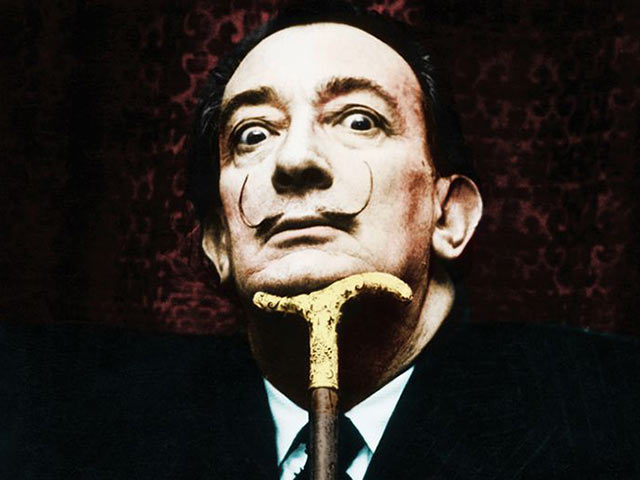

by Alina Livneva
January 22, '20Salvador Dali Art
When discussing the world of surrealist art, one of the most prominent names is Salvador Dali, the Spanish artist known for painting The Persistence of Memory, and known for his twirled, eccentric mustache. Dali is still a recognizable figure with continuous galleries being showcased throughout the world, along with many permanent museums dedicated to his work. The path to his eccentricities and his career in art, however, are not as simple as one might presume.
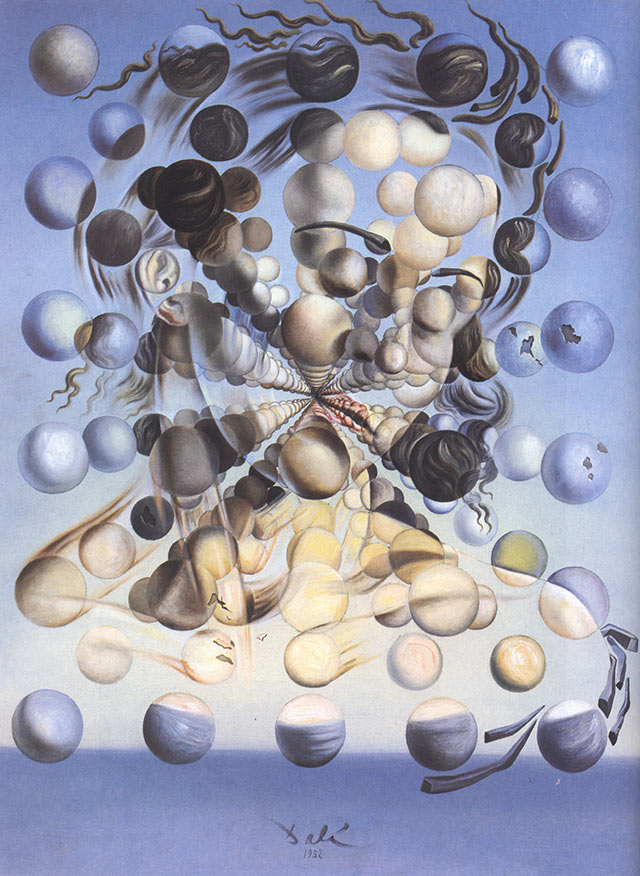
After Hiroshima and Nagasaki, Salvador Dali became captivated with nuclear physics and the theories of the atom disintegration. It was the time when he had renewed interest in Catholicism. This led to his Nuclear Mysticism period, in which his artworks often used ideas from modern science as a method of rationalizing Christianity. Realizing that physical substance, in general, was made up of atoms, Salvadore made his artworks appear to disintegrate into atoms. This painting is a portrait of his wife and muse Gala Dali. Her face is densely composed of populated spheres, representing atomic particles, which give a marvelous three-dimensional effect to the image. The title Galatea refers to a Classical Mythology sea-nymph, who was renowned for her goodness. Galatea of the Spheres is a famous painting from Dali’s Nuclear Mysticism period.
Life of Salvador Dalí
The surrealist was born on the 11th of May, 1904, in the small town of Figueres to parents Salvador Dali Sali and Felipa Domenech Ferres. Sali was an Atheist and legal notary, and Ferres being a supportive, Catholic mother. Dali had a brother, also named Salvador, who died nine months before his birth, and a younger sister, Anna Maria. As a child, he was brought to his brother’s grave and was told by his parents that he was the rebirth or reincarnation of his brother. This left a major impression on him, regarding himself and his brother as resembling each other like drops of water, but different reflections.
Dali’s father enrolled him into the Hispano-French School of the Immaculate Conception at the age of six, after realizing that public education would not have been the best for his son. During a break from the school year, his family took a trip to an abode off the coast of Spain in the small village of Cadaques, whereas an adolescent, he painted when his mentor, Ramon Pichot, taught him to. A year later, his father would showcase a gallery of his charcoal drawings in an exhibition at his local home. Two years later, his first appearance in a public gallery took place at the Municipal Theatre in Figueres.
His brother was not the only major death in the family to affect him. At the age of only 16, his mother died. Salvador Dali was devastated, calling it the greatest blow he had experienced in life. His relationship with Sali worsened after her death, his father continuing to parent with a harsh, disciplinary style. Throughout his life and career, Sali, besides all the support he gave early on, was critical of his son. When Dali eventually went on to be part of the surrealist movement, Sali saw it as unhealthy from a moral standpoint.
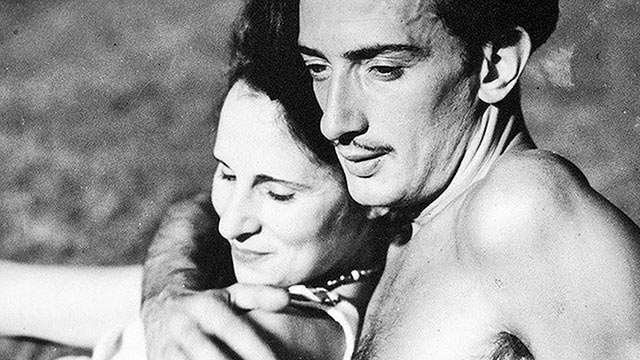
Salvador Dali wife Gala, her real name is Elena Ivanovna Diakonova. She was Russian, from Kazan, born in 1894. A secretive and intuitive woman, not afraid of controversy, she spent her childhood in Moscow and attended university courses at a finishing school in St Petersburg. Sali heavily disapproved, when Dali married his wife Gala. This consistent disrespect led him down the path of a lone wolf, who would get in trouble with authority figures in both educational and artistic establishments.
Salvador Dali style
In 1922, Dali began to take courses at the Real Academia de Bellas Artes de San Fernando, and while he experimented with all forms of art at the time, he did find a liking to cubism. This, mixed with an eccentric taste for late 19th-century fashion and a towering statue that commanded the attention of those around him (he later admitted to a “love of everything wealthy and privileged and excessive, a passion for luxury and a love of oriental clothes”), caught the eyes of a majority of his classmates. Eventually, this statute and presence caused tension between him and his professors, leading to expelling from the university just before the exams, blaming the faculty for being incompetent and unable to grade his work honestly. Coincidentally, that year, he painted The Basket of Bread, a very realistic depiction of four pieces of bread in a basket. Later on in his career, Salvador Dali would paint a similar, but a more prominent piece, Basket of Bread.
According to the principal spokesman of the movement, the poet and critic André Breton, who published the Surrealist Manifesto in 1924, Surrealism was a means of reuniting conscious and unconscious realms of experience so ultimately, that the world of dream and fantasy would be joined to the everyday rational world in “an absolute reality, a surreality.”
Salvador Dali surreal art
"Surrealism is destructive, but it destroys only what it considers to be shackles limiting our vision." - Salvador Dali
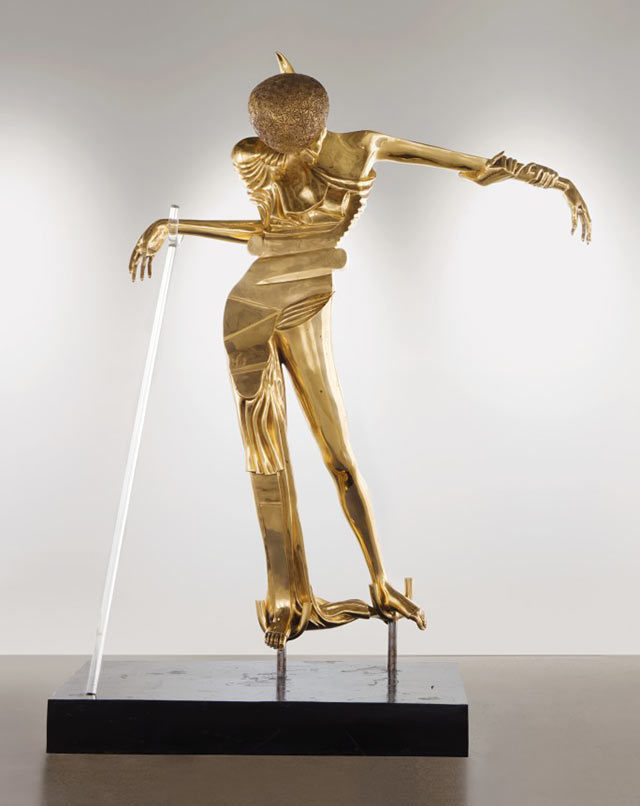
After being expelled, Salvador Dali frequently took trips to Paris and found inspiration in Pablo Picasso and Joan Miro. He began mixing the styles of cubism and surrealism, with Sigmond Freud’s methods of psychoanalysis to recreate dream-like imagery in his work. He eventually furthered this process, creating the Paranoiac Critical Method, where through irrational thoughts and paranoia, an artist can create works from dreams that otherwise might have been lost to time.
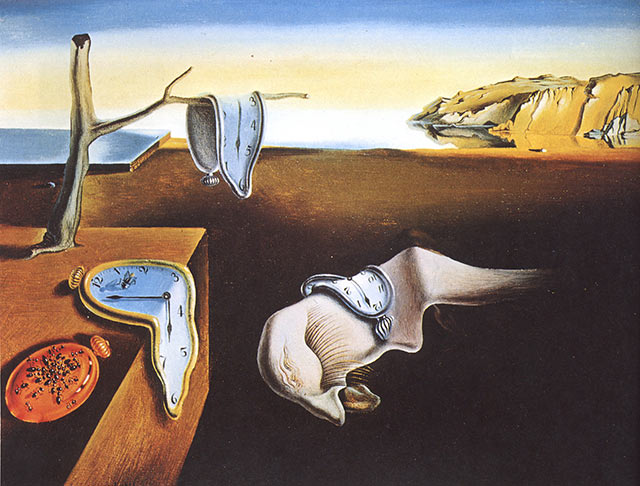
Dalí’s painting, The Persistence of Memory (1931), is a striking example of a surrealist artwork: the ants and melting clocks are familiar objects placed in a strange and odd setting. Dalí wants to twist our general ideas about what is ‘normal’ and ‘accepted.’
Salvador Dalí was known for his ferocious art and a public personality. These two elements rose him above the rest of the surrealists. His famous quote said it all, “the difference between the surrealists and me is that I am a surrealist.”
He was a pioneer of the movement - involved in all aspects of artistic creation from drawing, movies, fashion, painting, sculpture, design. He applied the concept of surrealism to everything he said and did. Salvador Dali's rebellious attitude towards politics and art set him aside and allowed him to create some of the most famous and recognizable artworks of the 20th century.
Dali's unconventional style and frequently outrageous ideas were highly sought in his work, be it fashion, advertising, photography, or film. His ideas and vision built the surrealism and artist a vast audience.
Even thirty years following his departure, his art and influences can be noticed almost everywhere in the world. If you ask anyone in the street, most will be familiar with at least his name and one of his images. The name Dalí is magic, and he remains an icon.

The intriguing Le cabinet anthropomorphic is an eponym derived from 1936 drawing The City of Drawers. Within Salvador Dalí's œuvre, figures with drawers were a prominent motif as they represented the psychoanalytic theories of Sigmund Freud, whom Dalí revered and admired. The various drawers emerging from the figure which sits on the floor with arm outstretched, allude to the convolutions and complexities of the human mind and the strength required to overcome life's most difficult challenges.
Among the most abundant artists of the 20th century, Dalí achieved both commercial and critical success in his lifetime. There are several museums devoted entirely to his works, including the Dalí Theatre and Museum, Figueres, Spain; the Salvador Dalí House-Museum, Cadaqués, Spain; and the Salvador Dalí Museum, St Petersburg, Florida.
Salvador Dali is represented in the Museum of Modern Art, New York. His powerful, visionary images continue to perform well at auction. According to Sotheby’s Mei Moses, the average compound annual return for Salvador Dalí resold at auction between 2003 and 2017 was 7.3%. A remarkable 88.2% of 153 such works increased in value.
Salvador Dali work
Dalí’s art drew from his everyday life and extracted seemingly arbitrary things such as infinite desert plains, marble statues, bicycles, or telephones and used them as icons where through their isolation, they became symbols for deeper emotional themes.
Dalí explored his fears and fantasies through these symbolic images captured in various mediums.
Dalí Melting Clocks, Dalí Ants, Dalí Eggs, Dalí Crutches, Dalí Elephants, Dalí Drawers, Dalí Snails.
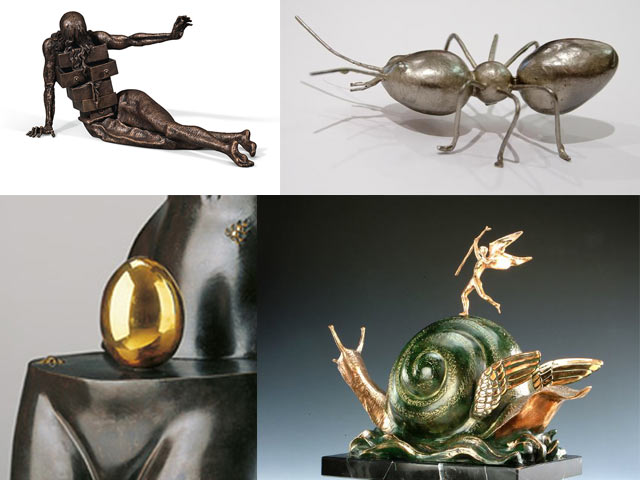
Salvador Dali continued through the 1930s, creating surrealist art, but his presence was becoming an annoyance to other artists since he was an apolitical man. With the rise of fascism in Germany affecting Europe in the years before World War Two, other artists saw the movement as a counter-cultural phenomenon. In contrast, Dali kept his art separated from the world around him. He was even accused of defending Hitler, but he refuted the claim, claiming to be “Hitlerian neither in fact nor intention.”
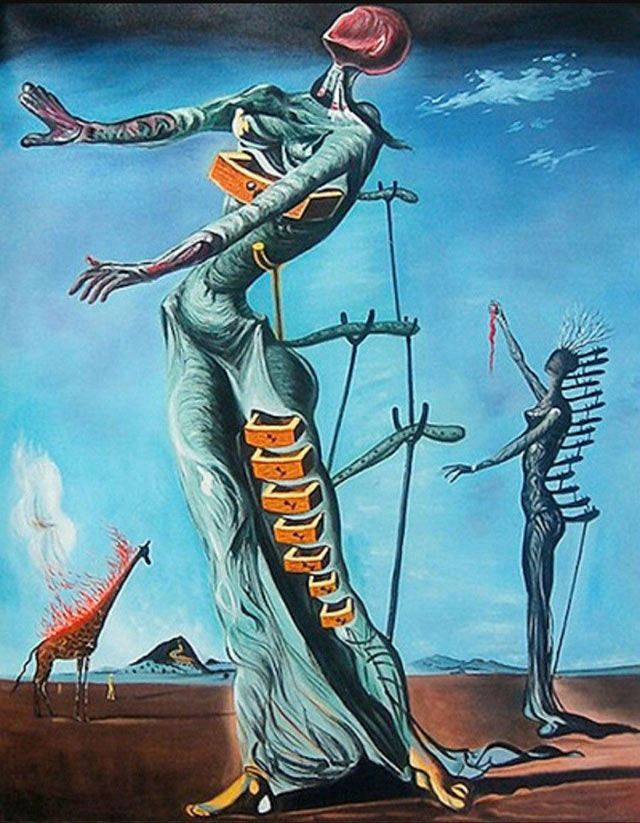
The Burning Giraffe
The Burning Giraffe is perceived as an expression of the inner struggle of Salvador Dali with the civil war going on in his beloved home country. The piece depicts two feminine figures with undefined phallic shapes protruding from their backs. The forearms, hands, and face of the nearest figure are stripped to the muscular tissue under the skin. Noteworthy, there are opened drawers sticking out from the chest and left leg of the figurine. Salvador Dali was a great admirer of neurologist Freud, and Freudian theories influenced several paintings of Dali. The open drawers can be traced to Freud’s psychoanalytical method and refer to the inner, subconscious within man. Dali described the burning giraffe image in the background as “the male cosmic apocalyptic monster.” He believed it to be a presentiment of war.
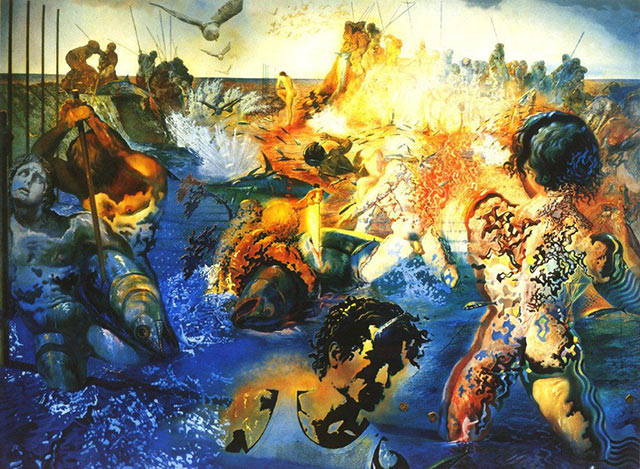
This painting was created by Dali at the end of his outstanding career and is seen as his last masterpiece. He spent two years creating the piece in which, along with surrealism, he used styles such as Pointillism, geometrical abstraction, Action painting, Pop Art, and psychedelic art. Spanning images from ancient Greek sculpture to modern cinema, Tuna Fishing depicts the vicious struggle between men and large fishes as an intention to represent the restricted universe. The artwork is dedicated to Jean Louis Ernest Meissonier, a 19th-century French artist known for his paintings of battle scenes. Salvadore Dali considered Tuna Fishing his most ambitious work. His fans perceive it as a testament to his profession and career mastery.
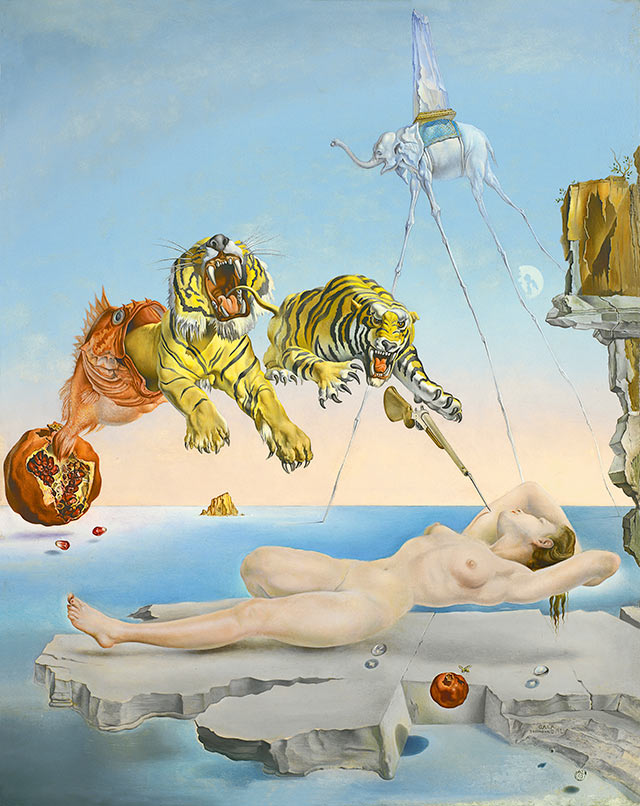
Salvador Dali said that this piece was thought “to express for the first time in images Freud’s discovery of the typical dream with a lengthy narrative, the consequence of the instantaneousness of a chance event which causes the sleeper to wake up.” It depicts the sleeping figure of Gala Dali, the artist’s wife, floating above a rock. Beside her naked body, two drops of water, a pomegranate, and a bee are also airborne. Gala’s dream is provoked by the continuous humming of the bee and is portrayed in the upper half of the piece. In a succession of images, a pomegranate bursts open to release a giant redfish from whose mouth two ferocious tigers emerge together with a bayonet that will soon wake Gala from her tranquil sleep. The elephant, later a recurring image in Dali’s works, is a distorted version of Elephant and Obelisk, a sculpture by famous Italian artist Gian Lorenzo Bernini.
He was put on a trial by his peers, barely avoiding exile from the movement, thanks to his enthusiasm for American pop culture, something Breton and his fellow European Surrealists disdained. Eventually, this passion led to expulsion from surrealists in 1939, other artists referring to him in the past tense, signifying a metaphorical death in their eyes.
Dali was the most known surrealist artist due to his work and his eccentric personality, with galleries continuing to showcase works like the Rainy Taxi, the Lobster Telephone, and the Mae West Lips Sofa.
Dali’s passion for art
Dali’s passion for art was his greatest strength, and he continued to paint and ventured into the worlds of film, photography, writing, and sculpture. Today, museums in Spain, France, the United States, Germany, and Japan showcase hundreds upon hundreds of his works. Dali lives on as one of the most famous and most memorable artists of his genre and time.
Dali spent the mid-career and late years of his life between his beloved Catalonia, Spain, and the United States, collaborating with many artists, canoodling with social elites, and creating stories for the news. After Gala’s death in 1982, Dali lost much of his will to live. He purposely dehydrated almost to the point of death. There was also a mysterious fire in his apartment in 1984. He was saved, but many thought it was a suicide attempt. He died of heart failure five years later at the age of 84.

